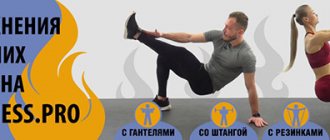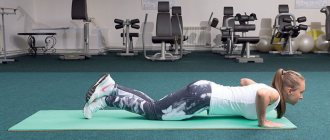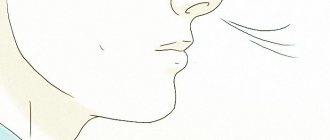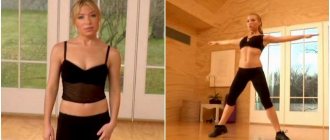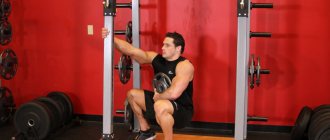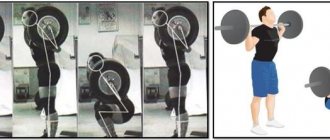Squats are one of the universal exercises. Helps improve joint health and blood circulation. With regular practice, a beautiful abs, buttocks, and thighs are formed. But to achieve all this, you need to know how to breathe correctly during regular squats and weight exercises.
Correctly performed squats will help you shape your figure.
Correct breathing technique
Proper and deep breathing when playing sports is one of the key elements of effective physical training.
At the same time, sufficient oxygen supply to the body is important not only when running a marathon or swimming, but also when performing any strength exercises
However, despite the fact that the technique of proper breathing is quite simple and intuitive, most people breathe excessively shallowly and unevenly during training. It is necessary to remember that correct and healthy breathing is, first of all, breathing through the nose and using the diaphragm.
Remember how small children breathe - when they inhale, the upper part of their tummy slowly rises, falling when they exhale, while the chest practically does not move. This type of breathing through the nose is called “diaphragm” and is the healthiest and most natural for humans.
In turn, the diaphragm is an internal muscle that separates the chest and abdominal cavities and serves to expand the lungs. In fact, the ability to engage the diaphragm in the breathing process distinguishes shallow chest breathing from deep and full abdominal breathing.
Why is it harmful to breathe through your mouth?
Runners know that breathing through your mouth during a workout significantly impairs your performance. The person seems to be taking deep breaths, but he immediately exhales the air. This negatively affects the percentage of oxygen absorption(1) and makes you breathe even more often, completely breaking the rhythm.
When actively breathing through the mouth, the muscles of the diaphragm seem to pinch and limit the lungs, since they move back and forth, and not up and down, as with deep breathing through the nose. Among other things, in the case of winter running, the habit of inhaling air through the mouth is a direct road to sore throat and colds (2).
Breathing during strength training
The main rules of breathing during strength training are that you should breathe through your nose, and the weight should be squeezed out as you exhale. For example, when doing push-ups, you need to lower yourself down as you inhale, pushing off the floor as you exhale. When doing pull-ups, exhale as you go up, and inhale as you go down.
The breathing itself, as already mentioned, should be carried out using the diaphragm - this will activate the internal muscles of the core and abs, creating natural support and protecting the spine from injury. Exhalation should be easy and natural, without strained screams and moans.
Short inhalations and long exhalations
Proper breathing during sports is approximately 7-8 cycles of slow inhalations and exhalations per minute. First, take a deep breath through the nose for 2-3 seconds, followed by a calm exhalation for 3-4 seconds (again, through the nose) and a final pause for 2-3 seconds.
When breathing through the mouth, 10 to 20 cycles of short inhalations and exhalations are usually performed per minute, since the body is chronically lacking oxygen (3). We also note that the habit of holding your breath while doing exercises is especially dangerous, since it increases blood pressure.
How to learn to keep your back straight and level? The best exercises to correct posture at home.
Advice!
Take the most comfortable position for you - sitting, standing or lying down. Place your left hand on your chest, your right hand on your stomach. Relax and try to breathe normally. Spend a few minutes learning exactly how you breathe. Notice whether your stomach or chest moves as you breathe.
If your stomach hardly moves, lightly massage it with your palms in the navel area, while trying to breathe so that the air allows the abdominal muscles to “open up”. At the same time, make sure that your breathing is long, deep and carried out exclusively through the nose and not through the mouth.
Consequences of improper breathing
The habit of inhaling and exhaling air through the mouth not only impairs the supply of oxygen to the body, but also leads to weakening of the muscles of the diaphragm and the associated internal abdominal muscles. Ultimately, this begins to negatively affect your posture, contributing to the development of hourglass syndrome.
The lower ribs and pelvis are contracted, minimizing the arch in the lower back and forcing the body inwards.
This is especially pronounced in those who lead a sedentary and sedentary lifestyle - this is why it is important for such people to practice yoga to improve breathing techniques
***
Correct breathing is even, slow and deep breathing through the nose.
When performing strength exercises, this is especially important, since only such breathing will activate the internal muscles of the core and create support for the spine
- Breathe right!, source
- How to Breathe Properly, source
- How you can breathe your way to good health, source
- Internal abdominal muscles
- How to improve your posture?
- Anterior pelvic tilt
Types of breathing
Scientists distinguish three types of breathing:
- Abdominal or diaphragmatic. This type of breathing is typical for men. Due to the increased work of the diaphragm, oxygen consumption occurs. The diaphragm increases intra-abdominal pressure and creates anterior displacement of the abdominal wall.
- Chest. Most often, this type of breathing occurs in women. Oxygen consumption occurs due to contraction of the intercostal muscles. During chest breathing, the chest expands and rises slightly.
- Mixed breathing is usually found among professional athletes. In this case, the abdominal and thoracic types of breathing are mixed, that is, both the diaphragm and the intercostal muscles are involved in the gas exchange process.
It is best to use mixed breathing during training. It avoids shortness of breath and fully saturates the body with oxygen.
How to breathe when doing Bubnovsky squats?
Sergei Bubnovsky, who is the author of many books on physical culture, has developed certain recommendations for breathing techniques during squats.
In his opinion, it is effective for every person to adhere to the following rules:
When performing any physical activity, in particular squats, it is important for a person to monitor his breathing. The degree of oxygen saturation of all cells and tissues, the functioning of the cardiovascular system, the load on muscles, etc. depend on this.
If the technique of inhalation and exhalation is not followed, there is a risk of losing consciousness, worsening heart function, and also physically not being able to withstand the entire workout to the end.
Blitz tips:
- do not forget to rest between sets of squats;
- before starting an exercise with a barbell, you need to make sure that your breathing has leveled out;
- If breathing is not restored even after 10-15 minutes after the end of the workout, even though the load was feasible, you should consult a doctor.
Squats are one of the best exercises for developing your lower body. With its help, you can both increase muscle mass and lose weight. It is due to its versatility and high efficiency that squats have gained high popularity.
Very often they discuss some technical issues regarding the correct execution, but how to breathe when doing squats is not discussed in detail. Meanwhile, this is one of the important points. For the normal functioning of all processes - gaining muscle mass or losing weight, the body requires oxygen.
Abdominal breathing is the best solution for squats.
And this applies to absolutely all exercises, in particular basic, multi-joint ones.
Proper breathing during squats is very important, since the body spends a lot of energy and requires oxygen, which promotes fat oxidation. It’s worth noting right away that training in stuffy rooms is a bad idea.
The load on the heart increases, and when performing exercises in conditions of lack of oxygen, you can lose consciousness
It’s worth noting right away that training in stuffy rooms is a bad idea. The load on the heart increases, and when performing exercises in conditions of lack of oxygen, you can lose consciousness.
Breathing during squats
First, let's look at squats without a barbell. Typically, bodyweight exercises are used as cardio to lose weight and maintain muscle tone. Therefore, first of all, it is necessary to perform an intense warm-up to prepare the lungs for the load and bring the heart rate to the aerobic zone. The breathing technique when warming up does not have strict recommendations; breathe as comfortably as possible.
After warming up, stand up straight and straighten your back. Inhale and squat at the same time. Exhale as you rise up. Proper breathing during fast squats without weight should not be deep. If you breathe deeply, you will soon lose your pace and feel short of breath. Therefore, take medium inhalations and exhalations.
There is no need to delay inhaling oxygen either in the lower phase of the movement or during the ascent.
Now let's look at squats with a barbell on the shoulders. Since these are strength exercises, you should warm up well before performing them.
In this case, pay attention not to preparing the pulse, but to warming up the muscles and joints of the legs. Do 2-3 sets of squats without weight, perform simple joint exercises
This will help prevent injury and enhance muscle response when lifting heavy weights.
After warming up, go to the racks and remove the bar from the supports. Inhale smoothly and lower yourself into a squat. Hold your breath midway through the movement. Once you get past the bottom point, climb up. Exhale after completing half the lifting amplitude. Such breathing during squats with a barbell increases intra-abdominal pressure, which increases the tone of the body muscles and helps lift heavy weights.
The technique of power squats with delayed oxygen consumption has its opponents. The main complaint is an increase in intra-abdominal pressure, which leads to overstrain of the cardiovascular system.
Yes, there really is such a risk. But this is precisely why squats with heavy equipment are contraindicated for athletes with serious pathologies of the heart and blood vessels.
Correct breathing: additional recommendations
Squats, how to breathe correctly during which we are considering, will be more effective if you adhere to the following recommendations:
- When doing fast squats, breaths should be shallow and frequent . If the workout is smoother and slower, then make sure that your breathing is measured and unhurried.
- When we inhale, the muscles relax to expand. As you exhale, they become narrower and tense. If you want to pump up your legs while working out, try to empty your lungs as much as possible when doing lifts. If you want to improve your posture or tighten your stomach further, inhale air when you return to the starting position.
- If you do not have problems with blood pressure, you can try breathing as follows. In the starting position, inhale sharply. In the middle of the amplitude, without reaching the “dead point,” hold the air. You cannot exhale when you go down, so that your balance is not disturbed. Rise to the middle again, then suddenly empty your lungs. Returning to the starting position, hold your breath again for a few seconds.
- If you are a beginner, start with easy squats. Watch your breathing, but don't concentrate all your attention on it. Choose breathing pace . This will help you improve your endurance and improve your workout performance. It is better to immediately master the breathing technique, and then breathe correctly automatically, rather than try to relearn it after some time.
- Proper breathing helps make squats easier, and at the same time, proper exercise technique helps you maintain proper breathing. Squatting is one system where everything is interconnected. If you lean your torso forward or exhale too early, you will notice that your body's balance is shifted and it becomes more difficult for you to breathe.
Squats, which you already know how to breathe in, require that you stand in a tedious stance with your feet shoulder-width apart, heels together and toes out. As you do them, imagine that you want to sit on a chair, keeping your chest and back straight. It's worth going as low as you can. It is important to maintain balance and keep your gaze straight. When lowering, breathing should be clear. Before starting the next approach, you need to rest a little, taking at least two deep breaths and exhalations.
In principle, there is nothing complicated about how to squat correctly and how to breathe while doing it. You just need to remember the basic pattern of proper breathing. At first it will need to be controlled so that the body gets used to exactly this pace, and over time you will breathe correctly without putting any effort into it, thereby increasing the effectiveness of your workout.
Classic squats: technique of execution
I.P. Legs shoulder-width apart, slightly bent at the knees and hip joints. The turn of the toes depends on the width of the feet - the wider the feet, the greater the turn. In any case, the socks must be positioned so that during squats the direction of movement of the knee joint will coincide with the long axis of the foot. When performing the exercise with dumbbells, they are held in the lowered hands. The back is straight, not rounded. The body should not be tilted forward too much. Shoulders laid back. To maintain normal curves of the spine, the gaze must be directed forward and upward throughout the entire exercise. The head and neck are exactly above the back.
Phase 1: lowering into a squat. This movement is performed while inhaling (about 75% of the maximum voluntary inspiration). The legs bend at the hip, knee and ankle joints. The pelvis moves down and back simultaneously with the movement of the shoulder girdle down and slightly forward. Back straight
The projection of the general center of mass passes through the middle of the ankle joint, attention is focused on preventing the transfer of the general center of mass (GCM) to the toes, by consciously controlling the load on the heels. Ratios of felt loads: 1/3 on the toes, 2/3 on the heels. Such actions ensure minimal forward movement of the knees, which prevents overload of the ligamentous apparatus of the knee joint and allows greater use of active muscle contraction with a decrease in the contribution of serial and parallel elastic muscle components to movement.
End position
The depth of the squat should be determined by the ability to maintain normal lumbar lordosis while performing the movement. Stopping while working is not recommended. Typically the decline continues until the thighs are parallel to the floor or slightly lower. After which there is a slowdown, and a smooth rise, without jumping or jerking, as if pushing off the floor.
Phase 2: rising from a squat. The movement of the shoulder girdle up and back occurs simultaneously with straightening the legs and exhaling. Attention is focused on keeping the back straight. The knees should move in the same plane as the legs: when standing up, you cannot move your knees inward or, conversely, spread them outward. Exhale immediately after passing the heaviest point.
Exercise speed
The exercise should be performed slowly, concentrating on accurately fulfilling the technical requirements - this especially applies to beginners. Avoid jerking and, especially, jumping during the lifting phase. In order to master the correct technique, you just need to move slowly. As the skill improves, the speed can increase. But you shouldn’t get carried away: increasing speed can lead to loss of balance and injury, primarily to the knee joints.
Breathing during squats
You should breathe like this: inhale (approximately 75% of maximum), hold your breath while lowering, rise - and exhale
This is very important, as it helps the abs stabilize the spine and torso, and therefore develop greater force safely. Take your time to breathe between movements
Features of proper breathing
When performing squats, you need to breathe correctly only through your nose, trying not to use your mouth except for exhalations.
The thing is that the mucous membrane of the respiratory tract has receptors that send a signal to the brain to receive oxygen. You can exhale noisily if you have to work with heavy weights. If you are a beginner, it is better to exhale quietly without opening your mouth wide. You can inhale deeply for the first time before starting a squat, after which you can take repeated breaths each time at the top point. You need to exhale at the moment of greatest effort. That is, if we are talking about breathing when squatting, you will need to inhale at the top point, exhale at the bottom until the pelvis rises.
Do not try to inhale “in reserve” at the beginning of the exercise. Do not forget that an adult’s lung volume is no more than 6 liters, while they are never completely empty and during inhalation the maximum amount of air that can be stored is about 2 liters. An attempt to take as much air into the lungs as possible will cause rapid and shallow breathing, which in turn will lead to an uneven supply of oxygen to the tissues and can even cause loss of consciousness.
The most natural way to adapt the respiratory system to work during squats is to properly warm up before starting the exercise. During the warm-up, the lungs will be adequately ventilated, blood circulation will be established, and the muscles will be warmed up. Breathing exercises will help improve endurance with a general tonic effect. Try to alternate bodyflex training with strength training. This will help you improve your breathing while doing squats.
Correct breathing - healthy heart
Many girls, when starting training, don’t even think about why they need to breathe properly during physical activity. Intense training puts a lot of stress on the body, so it needs additional oxygen. This will allow all the necessary substances to flow evenly into the muscles and internal organs.
When the lungs are suddenly filled with oxygen or exhaled in jerks, the load on the heart increases. Hypoxia begins, which leads to fainting.
When squats, your back should be straight, you cannot lean forward, otherwise your breathing will constantly become difficult.
Lack of oxygen in the blood can lead to dizziness and fainting
A little about the anatomy of breathing
The best way to learn information about proper breathing is to understand how it all works from a physiological point of view.
During the exercises, you need to breathe exclusively through your nose, and you can only use your mouth to exhale. The fact is that the mucous membrane of the respiratory tract contains a set of receptors that signal to the brain to receive oxygen. Therefore, if you breathe first through your mouth, then through your nose and alternate this process, you can confuse your brain. The average lung volume of an adult is 6 liters. But, the maximum amount of air when inhaling is 2 liters. There is no need to try to take as deep a breath as possible at the beginning of the exercise.
Such an attempt can lead to an uneven supply of oxygen to the tissues, which in turn will cause loss of consciousness. Before performing an exercise, in particular squats, it is important not only to stretch the muscles, ligaments and joints, but also to prepare the respiratory system for work. Therefore, during warm-up you can use breathing exercises to ventilate your lungs.
This approach will improve strength and endurance.
Principles of proper breathing
To summarize, we list the main points:
- Inhalation is done in the negative phase of the movement, exhalation in the positive phase.
- Aerobic exercises are performed without holding your breath.
- Strength elements (including squats) are combined with holding the breath at the end of the negative phase and the beginning of the positive one.
- Before doing weightless squats, you need to prepare your heart and lungs for stress with an aerobic warm-up.
- You cannot breathe deeply during squats; inhalations and exhalations should be short.
- It is forbidden to hold the exhalation of air throughout the entire positive phase.
- It is not recommended to perform power squats for athletes with heart pathologies.
Proper breathing is the foundation on which the squat technique rests. Without following these principles, you will not be able to achieve a positive effect from the training. We recommend working on the technique of inhaling and exhaling with an empty bar, and only then moving on to power squats.
How to squat correctly
The main rule for performing squats with a barbell on the back is a preliminary warm-up to prepare the leg muscles and ligaments for the upcoming loads. The first two sets of the exercise should always be performed without additional weight and with arms extended forward, then one or two sets are performed with an empty barbell.
Since during squats, not only the front, but also the back surface of the muscles of the thighs works, it is necessary to pay special attention to preliminary stretching of the muscles of the buttocks and lower back - for this, during warm-up and performing squats with arms extended forward, it is necessary to linger in the lower position, while directing the tailbone as back as far as possible
Squats: biomechanics and technique
Proper barbell squat technique is key to achieving success in the form of larger leg muscles and minimizing pain in the lower spine and knees. In order to learn how to squat correctly, use a medium working weight and perform the exercise in 3-4 sets of 10-12 repetitions.
Place your feet shoulder width apart
The starting position of a classic squat is with your feet shoulder-width apart, toes slightly turned out to the sides (about 30° from the center). Wide-legged squats (called "sumo squats") are not recommended for beginners trying to learn how to squat properly, as they increase stress on the lower back.
Bring your shoulder blades together
The bar should rest on your upper back muscles, with your elbows pointing down. Hands should only support the barbell in a stationary position, but in no case support its weight. In addition, the chest should be as open as possible and the shoulder blades should be brought together. If you cannot support the barbell in this position, then its weight is too heavy.
Squat to parallel
At the bottom of the squat, your thighs should be parallel to the floor and your knees should not go beyond your toes. Be careful not to squat too low (this will put more strain on your lower back) or finish the movement too high (this involves only the front of your thighs, not the back of your thighs).
Watch your spine position
At the bottom of the movement, it is necessary to maintain the spine in a perfectly straight position - for this, the gaze should be directed to a point on the floor about one meter from you. Avoid the temptation to twist your head in an attempt to control the correctness of the exercise in the mirror - this can easily cause neck pain.
Rise up without using your knees
When lifting upward, the movement begins from the pelvis, only then the knees and body straighten. A movement that starts with straightening the knees is incorrect and violates the mechanics of the exercise. You should imagine that you are being pulled up by a rope tied to your pelvis, and not concentrate on pushing the barbell solely with the strength of your knees.
Keep your abs tight
At the top of the movement, in between repetitions, do not relax your knees and do not transfer the weight of the barbell to your toes. Stand as straight as possible, try to “stretch” upward, while tensing your abs and maintaining a calm breathing rhythm. If you can't do this (or your breathing becomes erratic), the weight of the bar is too heavy for you.
How to breathe correctly when squats?
A person can breathe in two main ways - through the chest and through the diaphragm. During chest breathing, air enters the chest. People who have nothing to do with sports at all usually breathe this way. During abdominal breathing, the abdominal cavity and chest are filled with air at the same time. That is, the body receives more oxygen. This type of breathing is considered correct when playing sports. Basic rules for breathing when squats:
- inhale air only through your nostrils;
- direct oxygen into the abdominal cavity by protruding the abdomen forward;
- As you exhale, contract your abdominal muscles.
Important aspects of inhalation and exhalation:
- The main load is carried out when exhaling, not inhaling.
- When a person inhales air, the abdominal muscles relax and the chest stretches. In this case, it becomes impossible to strongly strain the muscles.
- When you exhale, the muscles, on the contrary, become very tense. At the same time, the muscles of the back, abs, chest, etc. are grouped. This leads to the formation of a kind of corset.
- Squats accelerate the production of growth hormones and testosterone, due to which the muscle system grows.
- Burning fat deposits.
- Most of the body's muscle groups are involved, which strengthens the legs and spine.
- Increases endurance and eliminates shortness of breath. Therefore, in the future you will be able to jog and walk easier and longer.
- The risk of injury is reduced, since squats force all muscles to work harmoniously.
- The heart and circulatory system are strengthened, the body is saturated with oxygen.
- Tendons and joints in the lower extremities are developed.
- The development of varicose veins is prevented.
- Metabolism throughout the body accelerates.
When squats are used, many muscles are involved, so this exercise is always included in the basis of any training. First of all, the muscles of the back, buttocks, lower extremities and abs are developed.
Is the Valsalva maneuver dangerous?
The Valsalva maneuver is a procedure that creates high pressure in the middle ear, chest and abdominal cavities. It is used in otolaryngology to test the patency of the Eustachian tubes and in cardiology to identify heart pathologies. This maneuver is also used in powerlifting and weightlifting and helps athletes lift heavy weights.
The Valsalva maneuver used in strength sports is as follows: a person takes a deep breath (about 75% of the maximum possible), and then, at the moment of maximum effort, holds his breath for several seconds and tries to exhale air through a closed glottis. Breathing is held throughout the repetition, exhalation occurs after completion.
The Valsalva maneuver increases pressure in the chest. Through the diaphragm, it is transmitted into the abdominal cavity, which creates good support for the back and helps resist forces that tend to move the spine. As a result, the athlete can lift more weight and the risk of injury is reduced.
Effects of the Valsalva maneuver on the body
However, the Valsalva maneuver is often criticized because it increases blood pressure that is already high during strength training, which can lead to a heart attack.
Opinions differ on this issue. Dr. Jonathon Sullivan, a professor in the department of emergency medicine at Wayne State University, believes that only those who have pre-existing cardiovascular problems should be concerned about heart attacks when using the Valsalva maneuver.
In another study, Effects of Weightlifting and Breathing Technique on Blood Pressure and Heart Rate. Using this technique to raise a one-time max has been found to cause only minor changes in blood pressure. The Valsalva maneuver is only suitable for lifting really heavy weights for low repetitions.
Using the Valsalva maneuver for multiple repetitions with light weights can cause dangerous increases in blood pressure, rupture of blood vessels in the eyes and face, headaches, temporary blurred vision, and may cause fainting or cerebrospinal fluid leaks.
The last problem was described in the article Don't Hold Your Breath. Vishal Goyal and Malathi Srinivasan, MDs, of the Department of Medicine at the University of California.
A 50-year-old patient complained of headaches in the projection of the nose, continuous cough and constant unilateral nasal discharge. As a result of the tests, doctors discovered a leak of cerebrospinal fluid and damage to the nasal ethmoid bone. It turned out that the patient performed chest presses every day with a weight of 90–136 kilograms. At the same time, he held his breath during the bench press.
Doctors suggested that the patient's problems arose precisely because of the Valsalva maneuver. The training increased blood pressure and destroyed the meninges, which caused meningocele and cerebrospinal fluid rhinorrhea.
The Valsalva maneuver does help lift heavy weights, but it should not be used if:
- you are a beginner who does not have a set technique and a trainer who can monitor the correct execution of the Valsalva maneuver;
- you prefer exercises with light weights and high repetitions;
- you had problems with the cardiovascular system;
- you have had problems with intracranial pressure.
How to breathe correctly during squats?
We now come to the most interesting question. How to do this correctly? It is best to master the technique of proper breathing when squats without a barbell. Starting with your own body weight will be the most correct and optimal solution.
This is what it looks like:
- We take the starting position and exhale.
- We begin to smoothly lower down, slowly inhaling through our nose. You can’t breathe through your mouth, and it’s better to press your lips tightly. Don't rush or take too deep a breath.
- As soon as the pelvis is level with the knees and the lowest point is reached, the inhalation stops. Rising upward, he begins to exhale.
It is worth noting a few specific nuances:
- During the squat, your hands should be at your shoulders or in front of you so as not to interfere with the expansion of the chest.
- Also, you can finish exhaling when the body is halfway to the starting position. This will not be considered an error.
It is recommended to do 2-4 approaches, the number of repetitions is individual. Rest between sets – at least a few breaths. Or until breathing is completely normal.
What are the different types of breathing?
Even from school, we know that there are two types of breathing - abdominal and thoracic. By the way, it is worth noting an interesting fact that men and women breathe differently. For example, in the stronger sex, abdominal breathing predominates, while in the fair sex, chest breathing predominates. Let's look at each of them in detail:
- Breast. As a rule, it occurs in a calm state, when the body does not experience any physical activity. The chest expands and the ribs rise.
- Abdominal. It is considered a fuller and deeper type of breathing due to the fact that the diaphragm takes part in the process. As a rule, it is developed under conditions of testing physical activity.
What should your breathing be like when doing barbell squats?
After you have practiced squatting without weight, you can move on to weights.
Let us now consider in more detail how to breathe correctly when squatting with a barbell:
- We take a deep breath and exhale sharply.
- We take the barbell and take the starting position.
- We inhale, but leave about ¼ of the lung area free and smoothly lower to the bottom position.
- We lower ourselves to a position where the pelvis is level with the knees.
- When going up, you don’t need to exhale sharply. If you suddenly release air from your lungs, it will be difficult for your body. Therefore, carbon dioxide must come out gradually.
- We return to the starting position and at this time we finish exhaling so that the remaining carbon dioxide leaves the lungs.
Doing squats while holding your breath is strictly not recommended, because this will lead to pressure. And, as a result, to a sharp headache and the inability to continue training. And this can be fraught with negative health consequences.
Before you start working with weights, train without. This will help you understand when to inhale and exhale when squatting. The sooner you learn to control your breathing, the faster the results will be.
By developing the habit of breathing correctly, you can not only get the maximum results from the exercise, but also avoid health problems and injuries.
Therefore, at the earliest stages, pay serious attention to breathing techniques.
Exercises with dumbbells for chest muscles
Many famous bodybuilders prefer to use dumbbells instead of barbells during training when it comes to working the pectoral muscles. There is a completely reasonable explanation for this! During the bench press, the dumbbells can be lowered much lower, while the barbell limits the range of motion due to the bar. Therefore, when working with dumbbells, the pectoral muscles are stretched more, which causes additional stimulation and gives a powerful impulse for the growth of muscle fibers.
Rules for performing exercises
There are a huge number of exercises that are based on squats. Each complex has a special technique and nuances of execution that are unique to it. Some squats are good for gaining muscle mass or pumping up certain muscle groups, others help to shape your figure or say goodbye to extra pounds. But all squats are united by general rules that must be adhered to without fail when performing any set of exercises:
Be sure to choose comfortable shoes and clothes, as discomfort will not only irritate you, but will also prevent you from accurately adhering to the main squatting techniques. For partial squats, there should be a right angle between each thigh and the calf of the corresponding leg. The pelvis is always pulled back a little. It is important to keep the abdominal and back muscles tense so that it seems as if you are in a corset. You cannot slouch - your back should always remain straight. The knees should be in a straight direction, that is, they should not be turned inward or to the side. Watch your breathing. Do not make sudden jerks, squat and rise smoothly. It is strictly forbidden to raise your heels - they must lie firmly on the floor.
Let's rest properly
Proper breathing for squats involves a short rest between sets. It can last 1-6 minutes. While resting, breathe only through your nose. Try to take deep breaths, filling your lungs completely with air. Exhale slowly until your chest is completely empty.
It is worth breathing in the same rhythm. Return to exercise when your heart rate is restored and your body is saturated with oxygen.
When starting the next exercise, take a deep breath to open your lungs completely. Finish repetitions and sets with an exhalation. If you find it difficult to breathe after doing the exercise, you should reduce the load a little. This is your body's way of telling you that it is not ready for the number of reps or amount of weight you are giving it. It's better to start small and gradually raise the bar.
Features of proper breathing
How to breathe correctly when doing squats and other sports? Learning to breathe correctly is not difficult, the main thing is to follow these recommendations:
as you exhale, you need to pull your belly and stomach towards the spine, while the chest should be relaxed; inhale slowly through the nose so that the stomach remains flat; when taking a deep breath, it is important to feel the filling of the lungs, after which it is recommended to fill the diaphragm; at the peak of inhalation, exhale smoothly - as you master the technique, breathing will become almost imperceptible.
It is recommended to learn breathing techniques before going to bed; you can change your body position, constantly improving the techniques
For the first time, it is important to contact a trainer or a doctor at a physical therapy office. Breathing also depends on the type of sport and physical exercise:
- Running and athletics. Experts call this technique 2:2, when you take one deep breath for 2 steps, and exhale for the next 2 steps.
- Strength training (squats, presses, horizontal bars). A deep breath is taken with effort, followed by a slow, silent exhalation. This rhythm prepares the body for work, and also prevents the risk of spinal injury.
- Swimming. While swimming, it is recommended to take a deep breath through your mouth and exhale through your nose. This technique helps solve the problem of accidental water entering the nasal passages.
- Muscle stretching exercises. Inhale while standing, expanding the chest, and then exhale. Inhale and exhale slowly, deliberately, deeply.
For a beginner, 10-15 breathing exercises are enough to master the entire program for a specific type of physical activity.
